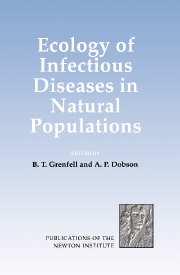Book contents
- Frontmatter
- Contents
- List of Participants
- Introduction
- BROAD PATTERNS AND PROCESSES
- PATHOGENS, INSECTS AND PLANTS
- IMPACT OF ECOLOGICAL AND GENETIC HETEROGENEITY
- Environmental Influences on Host Immunity
- Modelling the Immuno-Epidemiology of Macroparasites in Wildlife Host Populations
- Spatial Dynamics of Parasitism
- Spatial Dynamics Group Report
- Genetic Diversity in Host-Parasite Interactions
- Genetics and Evolution of Infectious Diseases in Natural Populations Group Report
- Beyond Host-Pathogen Dynamics
- Glossary
Modelling the Immuno-Epidemiology of Macroparasites in Wildlife Host Populations
Published online by Cambridge University Press: 22 January 2010
- Frontmatter
- Contents
- List of Participants
- Introduction
- BROAD PATTERNS AND PROCESSES
- PATHOGENS, INSECTS AND PLANTS
- IMPACT OF ECOLOGICAL AND GENETIC HETEROGENEITY
- Environmental Influences on Host Immunity
- Modelling the Immuno-Epidemiology of Macroparasites in Wildlife Host Populations
- Spatial Dynamics of Parasitism
- Spatial Dynamics Group Report
- Genetic Diversity in Host-Parasite Interactions
- Genetics and Evolution of Infectious Diseases in Natural Populations Group Report
- Beyond Host-Pathogen Dynamics
- Glossary
Summary
Introduction
Quantitative approaches to parasite population biology can be broadly classified into two research areas. The first body of work is essentially epidemiological, concentrating mainly on infections of humans (Anderson and May 1991) and managed farm animals. A major focus here is the role of host immunity in determining patterns of infection, particularly in the case of long-lived helminth parasites (Quinnell and Keymer 1990). This area has recently received considerable theoretical attention, particularly in the derivation of immuno-epidemiological models, which seek to account for parasite age-intensity profiles in terms of simple phenomenological models for immunity (Anderson and May 1985a, Grenfell and Michael 1992, Woolhouse 1992).
The second area (and the subject of this volume) is essentially an ecological examination of the interaction of parasites with their (naturally-fluctuating) host populations (Anderson and May 1978, May and Anderson 1978). Unlike many human infections, where host dynamics can often be neglected, the focus here is on the dynamics of the host-parasite interaction (Roberts et al. this volume) and, increasingly, with questions of coevolution (Lively and Apanius, this volume). In terms of host-macroparasite population dynamics, a crucial issue is the balance between parasite induced host mortality and reproductive limitations due to parasitism (which tend respectively to stabilize and destabilize host dynamics (Anderson and May 1978, May and Anderson 1978). The statistical distribution of parasites among hosts has a major impact on both the above areas.
- Type
- Chapter
- Information
- Ecology of Infectious Diseases in Natural Populations , pp. 362 - 383Publisher: Cambridge University PressPrint publication year: 1995
- 14
- Cited by



